Abstract
An experimental study was conducted to investigate the flexural mechanical properties of mineralized (massive sulfides) and non-mineralized (meta-rhyolitic tuff) rock samples using a three-point bending test. Mineralogical analysis was conducted on samples from both rock categories, followed by the determination of physical properties (P-wave velocity and density). In the massive sulfide zones, there are three distinctive zones of mineralization, each exhibiting varying degrees of pyritization: the intense pyritization zone (formerly Zone A) exhibited extensive pyrite replacement of sphalerite and chalcopyrite, the transitional zone (Zone B) displays intergrowths of pyrite and sphalerite, and the coarse sulfide zone (Zone C) features coarser, less altered sulfides—polyphase hydrothermal alteration, including sericitization, silicification, and amphibole veining. Mineralized rocks showed a 35.18% increase in density (3.65 ± 0.17 kg/m3 vs. 2.72 ± 0.014 kg/m3) attributed to dense sulfide content. The flexural strength more than doubled (99.02 ± 4.42 GPa vs. 43.17 ± 6.45 GPa), experiencing a 129% increase, due to homogeneous chalcopyrite distribution and fine-grained sulfide networks. Despite strength differences, deflection rates showed a non-significant 4% variation (0.373 ± 0.083 mm for mineralized vs. 0.389 ± 0.074 mm for metamorphic rocks), indicating comparable ductility.
1. Introduction
Sulfide mineralization in hydrothermal systems plays a critical role in concentrating economically valuable metals such as Cu, Zn, and Au [1]. However, post-depositional processes such as metamorphism and deformation significantly modify both the composition and texture of sulfide minerals, often redistributing trace elements along grain boundaries and creating microstructures that influence mechanical behavior [2,3]. During metamorphism, certain trace elements may decrease in abundance due to volatilization or redistribution, while others remain stable or even increase due to preferential partitioning into residual phases [4]. Mineralization processes, particularly those involving pyrite, chalcopyrite, and sphalerite, have been shown to alter the pore network and microstructure of host volcanic rocks, thereby influencing their mechanical properties [5,6]. These changes are further modulated by hydrothermal alteration, which can either weaken or strengthen rocks depending on the intensity and type of mineralogical transformation [7]. Sulfide enrichment, especially when finely disseminated and uniformly distributed, tends to enhance rock strength through cementation and pore-filling mechanisms [8,9].
Hydrothermal alteration has a significant impact on the physical and mechanical properties of volcanic rocks, influencing their behavior in geothermal and volcanic systems. The effects vary depending on alteration type, intensity, and rock characteristics [10,11]. Mineral precipitation can reduce porosity and permeability while increasing strength and stiffness [12,13]. Conversely, dissolution and clay formation may weaken rocks [14]. These alterations affect fluid circulation, potentially leading to pore pressurization and increased volcano instability. The degree of alteration and rock type are primary controls on physical and mechanical properties, followed by mineralogical composition. Understanding these processes is crucial for predicting reservoir quality in volcanic rocks [15] and assessing fault zone mechanics [7]. Monitoring hydrothermal alteration is crucial for assessing volcanic hazards and exploring geothermal resources [16]. The mechanical behavior of volcanic and meta-volcanic rocks is influenced by multiple factors, including porosity, microstructure, temperature, and confining pressure [17,18]. In particular, textural characteristics such as grain size, shape, and mineralogy play a significant role in determining how rocks deform under stress [19]. The presence and orientation of veins and fractures further complicate mechanical responses, especially under dynamic loading conditions [20].
Flexural strength—the ability of a material to resist bending—is a crucial parameter for assessing the stability of rock masses in engineering applications such as deep mining, tunneling, and infrastructure development [21]. While uniaxial compressive strength has been widely studied using methods such as triaxial compression testing [22,23], the flexural behavior of mineralized volcanic rocks remains less explored [24]. Experimental techniques, such as three-point bending tests, provide insight into fracture propagation and stress–strain behavior under bending loads, offering practical implications for design and safety assessments [25,26]. This study investigates the flexural response of mineralized massive sulfide and meta-rhyolitic rock samples obtained from an underground copper mine. Using integrated petrographic analysis, structural observations, and experimental testing, we identified three spatially defined mineralization zones characterized by variations in pyrite content and established a link between multi-phase hydrothermal alteration events and sulfide mineralization patterns. Our results demonstrate that mineralized rocks exhibit significantly higher flexural strength compared to their non-mineralized counterparts, a difference attributed to the uniform dispersion and dense packing of fine-grained sulfide assemblages, particularly chalcopyrite.
2. Experimental Work
2.1. Sample Preparation
Rock core samples were collected from both mineralized and non-mineralized zones of the Jabal Sayed underground copper mine. These zones were selected based on prior geological mapping and geochemical logging to ensure representative differences in sulfide content, mineralization style, and host rock lithology. From these cores, half-core samples were utilized for mechanical and petrographic investigations. This approach is common in geotechnical studies where one half of the core is reserved for geochemical analysis or archival purposes, while the other half is used for physical and mechanical testing [27,28]. Using a precision diamond saw-cutting machine, eight prismatic specimens were prepared from the half-core samples. Each specimen was cut to a uniform geometry, approximately 150 mm in length and 35 mm × 35 mm in cross-section, following ASTM recommendations for flexural testing of rock materials. This standardized shape ensured consistent stress distribution during mechanical loading and minimized geometric variability that could affect test outcomes, as shown in Figure 1.
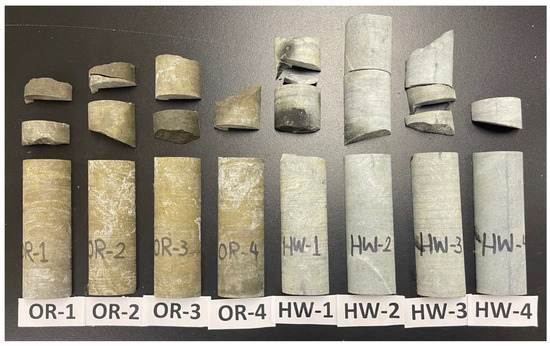
Figure 1.
Half-core hard rock samples for mineralized and non-mineralized zones (front-side view).
A small portion of each sample was separated before mechanical testing and subsequently prepared as standard petrographic thin sections (30 µm thickness) for microscopic examination. These thin sections allowed for detailed characterization of mineralogy, texture, alteration features, and microstructural controls on mechanical behavior.
2.2. Petrographic–Mineralogic Examination
Petrographic analysis was conducted to determine the lithological composition, textural characteristics, degree of deformation, and alteration history of both mineralized and non-mineralized rock samples. Initial macroscopic observations were carried out using a Leica S9i stereomicroscope (Leica Microsystems, Singapore), allowing for preliminary identification of mineral phases, veining, and textural heterogeneity. Representative areas of each sample were then mounted, polished, and analyzed under transmitted and reflected light using an Olympus BX53M research-grade polarizing microscope (Olympus Europa, Hamburg, Germany). Reflected light microscopy was particularly useful for identifying opaque sulfide minerals such as pyrite, chalcopyrite, and sphalerite, which are key components in the mineralized samples. Photomicrographs were captured using an Olympus SC180 digital camera (Olympus Europa) for documentation and further image analysis. This multi-scale approach enabled correlation between observed mineral textures and mechanical performance during flexural testing.
2.3. Flexural Strength Testing
Flexural strength was assessed using the three-point bending test, a widely accepted method for evaluating the bending resistance of brittle and semi-brittle materials, such as rock. In this setup, the beam specimen rests on two roller supports and is subjected to a centrally applied vertical load (P), resulting in maximum tensile stress at the bottom surface directly beneath the point of loading.
The tests were performed on a SANS UTM 300 kN universal testing machine (SANS Testing Machine Co., Ltd., Shenzhen, China), conforming to the ASTM A370 standard, which provides guidelines for tension testing of steel products but is often adapted for similar mechanical assessments in rock mechanics. A span length (L) of 120 mm was maintained between the two lower supports, with the upper loading plunger positioned precisely at the center, as shown in Figure 2. The test was conducted under displacement-controlled conditions, with a crosshead speed of 1 mm/min, to ensure quasi-static loading and minimize dynamic effects.
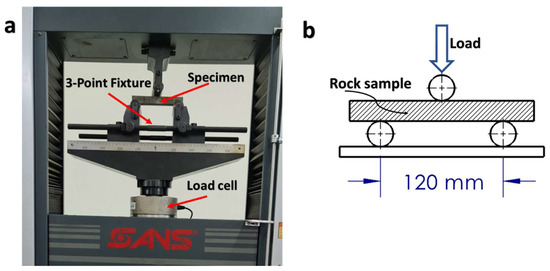
Figure 2.
Flexural test using a universal test machine (a) typical test showing the sample during the test, (b) schematic drawing shows the load and sample position during the test.
During testing, the system continuously recorded load–displacement data, enabling the calculation of flexural strength and elastic modulus based on beam theory. Flexural strength (σf) was calculated using the following formula [29]:
where
- P = maximum load at failure (N);
- L = span length between supports (mm);
- b = width of the specimen (mm);
- d = depth of the specimen (mm).
This experimental design facilitated a direct comparison of flexural responses between mineralized massive sulfide and meta-rhyolitic host rocks, highlighting the influence of sulfide mineralization on mechanical integrity under bending stress.
3. Results and Discussion
3.1. Petrographic Observation of the Mineralized and Meta-Volcanic Rocks
Reflected light microscopy of polished slabs from the mineralized specimen reveals a massive sulfide assemblage dominated by pyrite, with locally abundant sphalerite, minor chalcopyrite, and trace stannite. Macroscopic analysis of the sample identifies three distinct mineralization zones (Zone A, Zone B, and Zone C), which are differentiated by variations in grain size, sulfide density, and textural relationships (Figure 3). These textural features, including potential slumping and sulfide graded bedding, are consistent with characteristics commonly observed in exhalative VHMS deposits and appear to reflect primary depositional controls rather than metamorphic overprint. Zone A (Figure 4a,b) is characterized by extremely dense, finely crystalline cubic pyrite. Hence, Figure 4a shows a dense aggregate of finely crystalline pyrite (Py) with interstitial sphalerite (Sp). The sphalerite grains are irregularly shaped and appear to be remnants mechanically entrapped within the pyrite matrix. Figure 4b displays a similar texture, emphasizing the tight packing of pyrite grains and the presence of rare chalcopyrite (Cp) inclusions. The sphalerite grains exhibit embayed margins, indicating corrosion by pyrite.
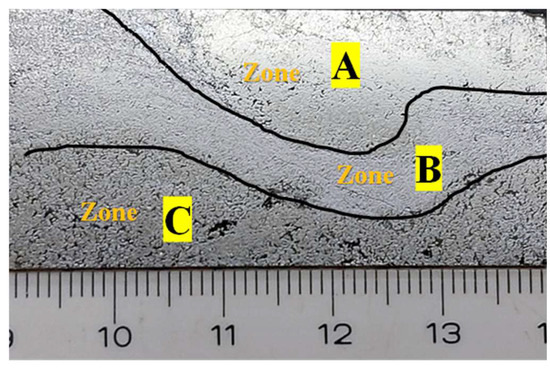
Figure 3.
Macrostructure of the mineralization zones in the OR sample.
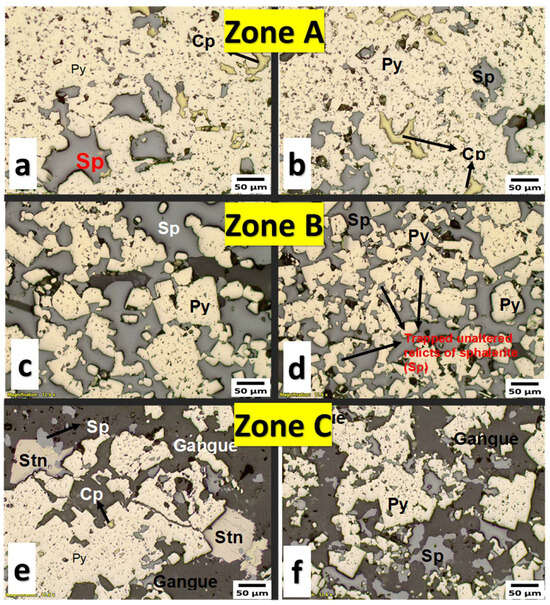
Figure 4.
Microstructure of the opaque minerals and their textures of Zones A, B, and C. (a) Zone A—extreme Pyritization, (b) Zone A—pyrite dominance and replacement, (c) Zone B—massive pyrite-dominant assemblage (by pyrite), (d) Zone B—relict sphalerite, (e) Zone C—coarser-grained assemblage, and (f) Zone C—less intense pyritization.
Pyrite forms tightly packed aggregates with interstitial sphalerite and rare chalcopyrite. Relict grains of unaltered sphalerite and chalcopyrite are preserved at pyrite grain boundaries, suggesting incomplete pseudomorphic replacement. These textures strongly suggest that pyrite is the late-stage overgrowth phase, replacing earlier-formed base-metal sulfides. Zone B (Figure 4c) contains a massive and pyrite-dominant zone with elevated sphalerite content, similar to Zone A, which is also massive and pyrite-dominant, with coarse-grained pyrite and sphalerite exhibiting intimate intergrowths. Sphalerite grains exhibit embayed margins and dissolution textures, consistent with resorption prior to overgrowth by pyrite, which envelops relict sphalerite grains. The trapped relics provide clear evidence of incomplete replacement and support the interpretation of pyrite as the late-stage replacive phase. The sulfides here are coarse-grained and well-crystallized, with pyrite and sphalerite exhibiting intimate intergrowths. Despite the abundance of sphalerite, microtextural evidence confirms that pyrite remains the replacive phase. Sphalerite grains display embayed margins and dissolution textures, while pyrite overgrowths encapsulate relict sphalerite. This zone is interpreted as transitional, reflecting intermittent sphalerite enrichment during ongoing pyritization. The presence of corroded sphalerite grains and pyrite overgrowths indicates that pyrite is the later phase, growing at the expense of earlier-formed sphalerite.
Zone C (Figure 4e,f) is texturally distinct, characterized by coarser-grained, less dense sulfides than Zones A and B. Figure 4e depicts a coarser-grained assemblage dominated by pyrite, with subordinate sphalerite, rare chalcopyrite, trace stannite, and abundant gangue minerals. Relict textures of unaltered sphalerite and chalcopyrite are partially enclosed by pyrite overgrowths, indicating less advanced pyritization compared to Zones A and B. Figure 4f emphasizes the less intense pyritization in Zone C, with larger sphalerite grains and more preserved relict textures. The gradational layering from Zone C to Zone A is evident in the increasing density and fineness of sulfide grains, correlating with the progression of pyritization. The mineral assemblage consists of pyrite, subordinate sphalerite, minor chalcopyrite, trace stannite, and abundant gangue minerals such as quartz and sericite. Pyritization is less advanced here, with preserved relic textures of unaltered sphalerite and chalcopyrite partially enclosed by pyrite. A clear gradational layering exists from Zone C (coarsest grains, lowest density) to Zone A (finest grains, highest density). This progression correlates with increasing intensity of pyritization, where pyrite replacement of base-metal sulfides (sphalerite, chalcopyrite) is most advanced in Zone A. In all zones, relict base-metal sulfides are restricted to isolated pockets within pyrite-dominated matrices, underscoring the pervasiveness of late-stage pyrite overgrowth.
3.2. Structural and Alteration Features of Meta-Rhyolitic Tuff
The meta-rhyolitic tuff rocks host significant sulfide mineralization and exhibit alteration assemblages typical of VHMS systems. These primary hydrothermal alterations are overprinted by later metamorphic effects, which must be clearly distinguished to avoid misinterpretation.
Primary Hydrothermal Alteration (VHMS-Related)
The protolith has undergone extensive polyphase hydrothermal alteration, initiated by early-stage phyllic alteration, characterized by the replacement of feldspar phenocrysts with fine-grained sericite. This sericite is typically fine-grained and closely associated with the original volcanic textures, indicating its formation during the initial stages of hydrothermal activity linked to VHMS mineralization. This was followed by the development of quartz ± amphibole ± epidote veinlets, forming a stockwork-like network that crosscuts the volcanic matrix. These veins represent progressive fluid circulation within the volcanic pile and are consistent with the typical alteration assemblages observed in volcanogenic massive sulfide (VHMS) deposits. The presence of epidote and amphibole in veins suggests relatively high-temperature conditions during this phase of alteration. Structurally, the rock preserves relict volcanic textures, including a fine-grained felsic mesostasis enclosing quartz blastophyres and their fragmented equivalents (blastophenoclasts), with grain sizes ranging from <0.30 mm to 1 mm. Quartz grains display anhedral to subhedral morphologies, consistent with crystallization under hydrothermal conditions. Following the hydrothermal alteration, the rocks underwent greenschist facies regional metamorphism, marked by recrystallization and deformation. Metamorphic recrystallization is evident in the recrystallized microcrystalline sericite, which now aligns parallel to the deformation planes, defining a penetrative foliation. This alignment reflects the influence of metamorphic strain rather than primary hydrothermal fabric.
Multiple phases of microfracturing and veining postdate the primary alteration assemblage. These include silica-, amphibole-, and epidote-rich veins, some of which cut across earlier vein sets, indicating a multi-stage history of fracturing and fluid flow during metamorphism. These later veins may reflect both syn-metamorphic fluid migration and/or retrograde processes. Additionally, both blastophyres and phenocrysts show subparallel alignment along foliation planes, further confirming the pervasive influence of metamorphic deformation. This structural realignment affects not only the phenocrysts but also the mesostasis, obscuring primary volcanic and hydrothermal textures in more intensely deformed domains.
Microtextural observations further elucidate these processes. Figure 5a,b reveal comparable textures and mineralogy, with the pervasive alignment of fine-grained sericite flakes underscoring deformation intensity and foliation. Figure 5c highlights silica alteration as fracture-filling micro-veinlets, while Figure 5d,e illustrate amphibole-rich veinlets (marked by dark dashed lines) crosscutting the host rock and accompanying mineralization (opaques). Figure 5f demonstrates advanced amphibole alteration, wherein diffusion into the host rock has produced radial mineral intergrowths rather than confined veinlets, emphasizing the dynamic interplay between alteration phases and structural evolution.
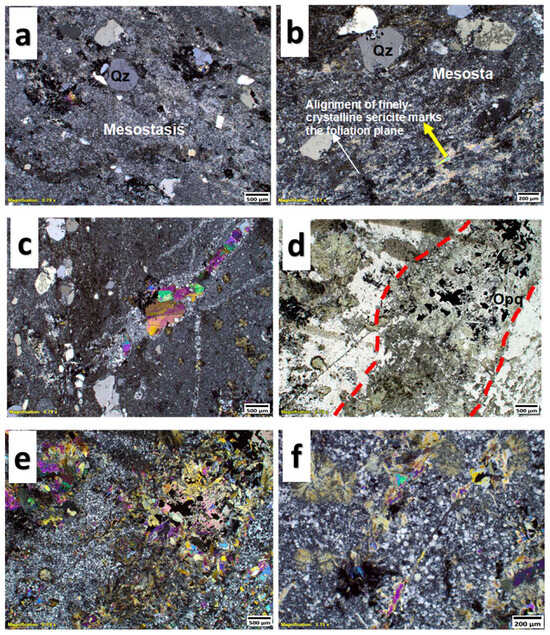
Figure 5.
The texture of the meta-rhyolitic tuff rocks. Images (a,b) show the un-equigranular blastoporphyritic texture, with finely crystalline sericite alignment defining foliation planes. Image (c) highlights silica alteration as fracture-filling micro-veinlets, while images (d,e) depict amphibole-rich veinlets and sulfide mineralization, respectively. Image (f) emphasizes advanced amphibole alteration, characterized by radial intergrowths within the host rock matrix.
3.3. Multi-Stage Sulfide Mineralization in Meta-Rhyolitic Tuff
Following the microscopic study, the images revealed a complex interplay of sulfide minerals within the host meta-rhyolitic tuff, highlighting a multi-stage mineralization process. The primary sulfide mineral observed is chalcopyrite (Cp), which dominates the opaque assemblage. Its occurrence in microfracture fillings and veins (Figure 6) indicates that fractures served as conduits for hydrothermal fluids carrying mineralizing components. These veins, primarily composed of chalcopyrite and gangue minerals, crosscut the host rock, signifying a post-host formation mineralization event. The anhedral form of chalcopyrite suggests it crystallized in confined spaces, lacking well-developed crystal faces. Furthermore, the fine-to-medium-grained nature of chalcopyrite points toward a relatively rapid crystallization process, possibly due to a sudden drop in temperature or pressure of the hydrothermal fluids. Scattered aggregates and fine disseminations of chalcopyrite throughout the host rock indicate a pervasive mineralization event, where fluids permeated the rock matrix, depositing chalcopyrite in available pore spaces and along grain boundaries. Bornite (Bo) is another significant sulfide mineral observed, albeit in minor amounts. Its presence in fine-grained crystallization and anhedral form suggest a similar formation mechanism to chalcopyrite. The boundary association between chalcopyrite and bornite (Figure 7c,d) indicates co-precipitation or sequential crystallization of these two minerals. The magnified image (Figure 7d) further emphasizes this association, revealing an intimate textural relationship between them. Sphalerite (Sp), though subordinate to chalcopyrite, plays a crucial role in understanding the history of mineralization. Its occurrence in boundary association with chalcopyrite and its ability to replace chalcopyrite, forming lace-like intergrowths (Figure 7e,f), suggests a later stage of sphalerite crystallization. This replacement texture, particularly evident in the magnified image (Figure 7d), indicates that sphalerite was introduced after the formation of chalcopyrite, potentially due to a change in the physicochemical conditions of the hydrothermal fluids. The observed replacement of chalcopyrite by sphalerite along grain margins indicates a later-stage hydrothermal overprint, consistent with open-space replacement processes rather than primary syngenetic deposition. This textural relationship suggests that the mineralization experienced significant post-depositional modification, potentially during regional metamorphism or subsequent hydrothermal events. The spatial association of these sulfide minerals with amphibole, a common product of hydrothermal alteration, implies that sulfide precipitation occurred in a chemically favorable environment created by fluid–rock interaction. Amphibole likely formed either before or contemporaneously with this hydrothermal mineralization event, supporting a model of syn- to post-metamorphic sulfide emplacement. These features distinguish the deposit from classical VHMS systems, where sulfide deposition typically occurs in a submarine exhalative setting without significant later remobilization or replacement. Instead, the evidence supports a model involving syn-metamorphic or late-stage hydrothermal fluid circulation, which may lead to localized remobilization and/or supergene enrichment of base metals.
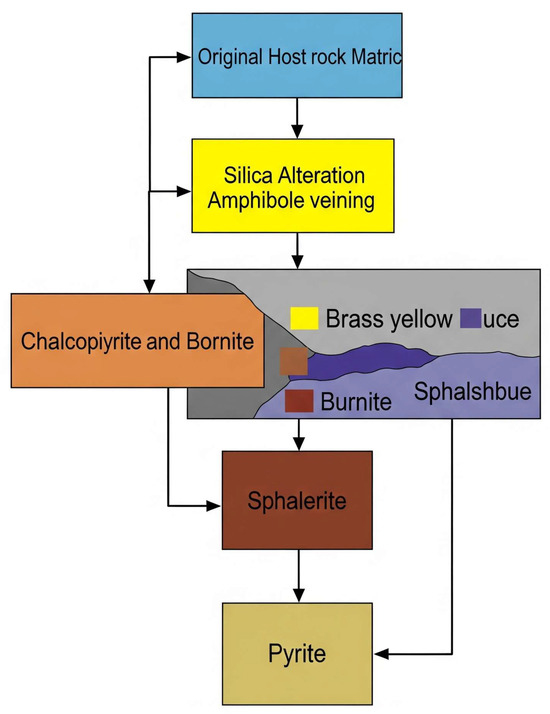
Figure 6.
Paragenetic sequence of mineralization flowchart.
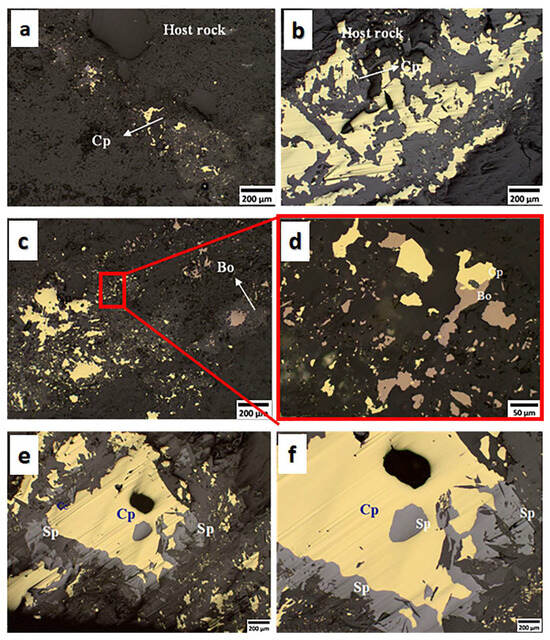
Figure 7.
Photomicrographs illustrating the progression of mineralization from sparsely disseminated to complex intergrown and replacement textures within the host rock and sulfide-rich zones. Image (a) shows disseminated chalcopyrite (Cp) in the fine-grained host rock. Image (b) highlights localized chalcopyrite (Cp) aggregates. Image (c) displays a sulfide-rich zone dominated by bornite (Bo). Image (d), a detailed view of image (c), reveals intricate intergrowths of bornite (Bo) and pyrite (Py). Image (e) presents a different sulfide-rich zone with coarse-grained sphalerite (Sp), chalcopyrite (Cp), and other sulfides (Cc). Image (f) demonstrates a replacement relationship, with chalcopyrite (Cp) overgrowing sphalerite (Sp) at a grain boundary.
3.4. Physical Properties
Density and P-Wave Velocity
The samples were cut and prepared with codes as previously discussed, as shown in Figure 8, to facilitate the density and P-wave velocity measurement process as non-destructive tests. Table 1 shows the observed P-wave velocity (Vp) and density of the two types of rock samples tested. Due to the heterogeneous nature of the metamorphic rock (HW), the typical density of the various samples shows slight variation, with a standard deviation of 0.014. For the P-wave velocities of numerous other sample groups, a standard deviation of 75.8 was observed (as depicted in Figure 9 and Figure 10); despite the heterogeneity of the analyzed samples, the selected categorization produced values for density and P-wave velocity that were relatively close and are frequently utilized in sample selection [30].

Figure 8.
The investigated samples with codes (OR) for mineralized rocks and (HW) for metamorphic rocks.

Table 1.
Summary of P-wave velocity and density measurements for mineralized (OR) and metamorphic (HW) rock samples.
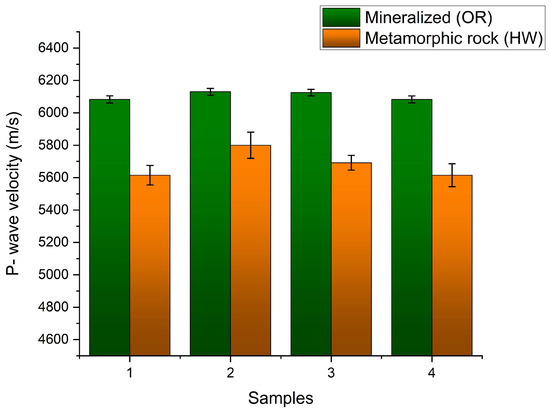
Figure 9.
The P-wave velocity of the categorized set of specimens.
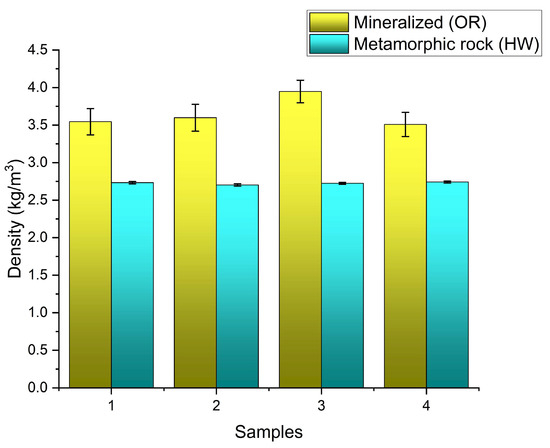
Figure 10.
The average density for the different tested specimens.
On the other hand, the mineralized rocks (OR) have a more homogeneous structure than the metamorphic rocks. The presence of dense sulfide minerals, including chalcopyrite, bornite, and minor sphalerite, resulted in a 35.18% increase in bulk density compared to the less mineralized meta-rhyolitic tuff. Hence, the average density was recorded at 3.65 ± 0.17 kg/m3. Moreover, the P-wave velocity increased by approximately 7.5% compared to metamorphic rock. This can be explained by the increase in mineralized elements in the rocks, which helps to accelerate the P-wave velocity in such a medium. In contrast, the metamorphic rocks slightly attenuate the P-wave velocity due to the rare chalcopyrite elements.
3.5. Flexural Strength Test Results
Flexural tests are performed by bending prismatic rock beams, and three-point load tests may be performed. Flexural strength, or the modulus of rupture, is calculated as the maximum tensile stress that occurs on the beam at peak loading. Table 2 presents the average mechanical properties, specifically those related to flexural strength, derived from three-point bending tests conducted on metamorphic and mineralized rock samples.

Table 2.
Mechanical properties of the investigated rocks.
The results indicate several key distinctions between the two rock types:
- ▪
- Average Maximum Load (kN): Mineralized rock samples demonstrated a higher average maximum load of 1.82 kN, indicating greater resistance to applied force before failure, compared to 1.57 kN for the metamorphic rocks.
- ▪
- Average Maximum Deflection (mm): Mineralized rocks exhibited a slightly lower average maximum deflection of 0.373 mm prior to failure, in contrast to 0.389 mm for the metamorphic rocks. This suggests a comparatively stiffer mechanical response in the mineralized samples.
- ▪
- Average Maximum Bending Strength (GPa): A notable difference was observed in the average maximum bending strength, with mineralized rocks displaying a significantly higher value of 99.02 GPa compared to 43.17 GPa for the metamorphic rocks. This substantial increase in flexural strength in the mineralized samples underscores the considerable strengthening effect imparted by sulfide mineralization on the host rock.
Figure 11 illustrates the fracture location following the completion of the bending test. The fracture position observed in the metamorphic rocks indicates that these fractures do not occur at the center of the specimen. The heterogeneity of the rock composition is the primary factor contributing to this phenomenon. The distribution of silica, amphibole, and epidote veins within the structure, along with the presence of coarse grains, is critical to understanding the structure’s susceptibility to amorphism. Central fracturing in mineralized samples suggests uniform stress distribution due to homogenous dispersion of fine-grained sulfides, particularly chalcopyrite. The uniformity of the mineralized elements with fine grains within the rock results in a fracture occurring at the center upon the application of load. The maximum force exerted during the three-point bending test for both metamorphic and mineralized rocks, along with the average maximum force, is illustrated in Figure 12. The metamorphic rocks exhibit non-uniform mechanical properties resulting from the random distribution and nonhomogeneous composition. Consequently, the variation in the applied force values is clearly illustrated in Figure 12a,c. In contrast, in the case of the mineralized rock, the values of the maximum applied load show lower variations compared to non-mineralized rock, as shown in Figure 12b. The uncertainty analysis showed that the variance between the recorded results of the metamorphic and mineralized rocks was 365.14 N and 136.6 N, respectively. Figure 13d shows that the average bending strength reaches 43.16 ± 7.12 GPa. On the other hand, the mineralized rock observed had similar bending strength results across the tested samples; hence, the average bending strength was recorded at 99.03 ± 4.3 GPa, which can be attributed to the uniform distribution of the mineralized elements. Due to the presence of chalcopyrite within the rock structure, it behaves like a metal to some extent, which enhances its mechanical properties, unlike metamorphic rocks.
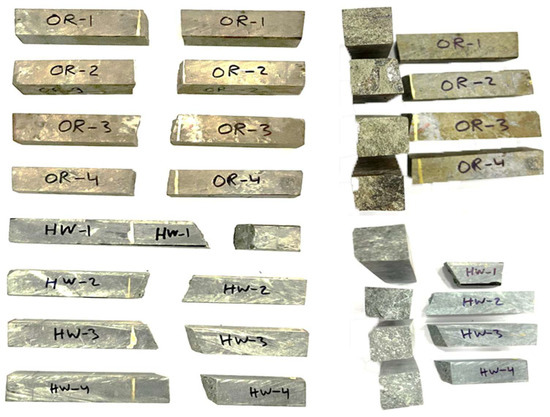
Figure 11.
The fracture position after the 3-point bending (flexural) test.
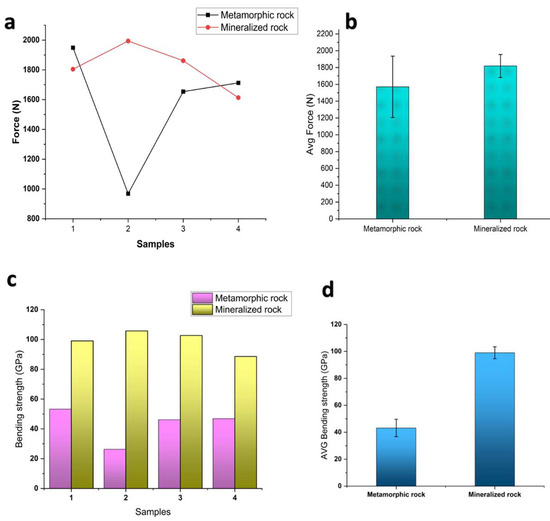
Figure 12.
Comparison of mechanical properties between metamorphic and mineralized rocks: (a) maximum applied force four different mineralized rock and metamorphic rocks; (b) avg. flexural strength; (c) bending strength force of four different mineralized rock and metamorphic rocks; (d) avg. bending strength.
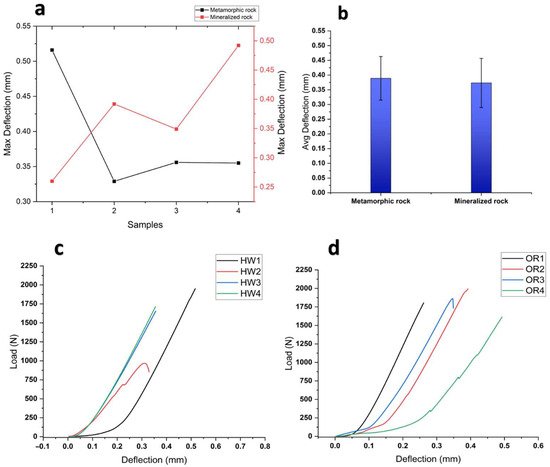
Figure 13.
Deflection as a function of applied force in 3-point bending test for metamorphic and mineralized rock, (a,b) maximum deflection and average maximum deflection, (c) strain rate of metamorphic rock, and (d) strain rate of mineralized rock.
Figure 13 shows the strain behavior of the tested sample for both types of rocks; thus, the metamorphic and mineralized rocks have approximately the same strain rate before the fracture point. The average deflection that was obtained from the metamorphic rocks is 0.389 ± 0.074 mm, while mineralized rocks have an average maximum deflection of 0.373 ± 0.083 mm; it is clear from this result that the difference between them is only 4%, which is not significant (Figure 13b). The main observation in the curves (Figure 13c,d) is the flexure behavior of both rocks; the metamorphic rocks have various behaviors during the flexure test, which can be attributed to the nature of the composition and the structure of such rocks. The mechanical properties of the metamorphic rock were influenced by the presence of silica, amphibole, and epidote veins inside the structure. Due to the heterogeneous distribution of these compositions and the rarity of chalcopyrite elements, the flexural behavior exhibits different shapes and various fracture points.
In contrast, the mineralized rocks contain small amounts of bornite and sphalerite, while chalcopyrite is the most commonly noted, occurring as fine- to medium-grained. The ultimate bending force was closed for all tested samples, regardless of their composition. The behavior of the flexural test appeared to be the same, with minor variations in deflection rate due to differences in mineral elements in such rocks.
4. Conclusions
This experimental study provides critical insights into the mechanical behavior of mineralized massive sulfide rocks and their non-mineralized host rocks (meta-rhyolitic tuff), revealing significant differences in flexural strength, deformation characteristics, and failure modes. The results demonstrate that mineralization—particularly through fine-grained chalcopyrite and pyrite enrichment—substantially enhances the flexural strength of the rock mass by up to 129% while maintaining comparable ductility to unmineralized rocks. This increase in strength is attributed to the dense, interconnected sulfide network formed during hydrothermal alteration, which reinforces the original rock fabric and reduces microcrack propagation under bending stress. Importantly, the fracture behavior of the two rock types diverges significantly: metamorphic rocks exhibit irregular, off-center fracturing due to heterogeneity and veining, whereas mineralized samples tend to fail consistently at the center—a reflection of more uniform stress distribution due to homogenous sulfide dispersion. This has direct implications for geotechnical design and stability assessments in mineralized zones, especially where underground infrastructure such as tunnels, shafts, or deep excavations is planned. The observed correlation between P-wave velocity and density in mineralized rocks further supports the use of non-destructive testing methods in field characterization, offering a reliable proxy for identifying zones of enhanced mechanical integrity. These findings are particularly relevant for resource development planning, where understanding rock strength variations can inform support design, blasting patterns, and excavation sequencing. From an engineering standpoint, the increased mechanical performance of mineralized rocks challenges conventional assumptions about orebody stability. In practical terms, the following represent promising future implications and research directions:
- ○
- Mining operations may benefit from simplified support systems in highly mineralized zones due to the inherent strength of these zones.
- ○
- Infrastructure projects in mineralized terrains can leverage these enhanced properties to reduce construction costs and improve long-term durability.
- ○
- Geological disposal programs, such as those considering host rocks for radioactive waste repositories, should carefully evaluate mineralized zones not only for chemical containment but also in view of their superior structural performance under mechanical stress.
Author Contributions
Conceptualization, E.B.M. and H.M.A.; methodology, E.B.M. and H.M.A.; software, E.B.M.; validation, H.M.A.; formal analysis, H.M.A.; investigation, E.B.M.; resources, H.M.A.; data curation, H.M.A.; writing—original draft preparation, E.B.M.; writing—review and editing, E.B.M. and H.M.A.; supervision, H.M.A.; project administration, H.M.A. All authors have read and agreed to the published version of the manuscript.
Funding
This research was funded via a KAU Endowment (WAQF) at King Abdulaziz University, Jeddah, Saudi Arabia. The authors thanks WAQF and the Deanship of Scientific Research (DSR) for providing technical and financial support.
Data Availability Statement
Data available in a publicly accessible repository.
Conflicts of Interest
The authors declare no conflicts of interest.
References
- Fontboté, L.; Kouzmanov, K.; Chiaradia, M.; Pokrovski, G.S. Sulfide Minerals in Hydrothermal Deposits. Elements 2017, 13, 97–103. [Google Scholar] [CrossRef]
- Boyle, A.P. Sulphide Metamorphism and Deformation—introduction. Mineral. Mag. 1993, 57, 1–2. [Google Scholar] [CrossRef]
- Liu, Y.; Yu, P.-P.; Zheng, Y.; Shan, H.-X.; Chen, X. Texture and composition evolution of sphalerite in metamorphosed depos its: An example from the Keketale Pb-Zn(-Ag) deposit, NW China. Ore Geol. Rev. 2024, 165, 105924. [Google Scholar] [CrossRef]
- Paradis, S.; Petts, D.; Simandl, G.J.; Sharpe, R.; Hamilton, T.S.; Fayek, M.; Jackson, S.E. Impact of deformation and metamorphism on sphalerite chemistry—Eleme nt mapping of sphalerite in carbonate-hosted Zn-Pb sulfide deposits of the Kootenay Arc, southern British Columbia, Canada and northeastern Washington, USA. Ore Geol. Rev. 2023, 158, 105482. [Google Scholar] [CrossRef]
- Giacometti, F.; Evans, K.A.; Rebay, G.; Cliff, J.; Tomkins, A.G.; Rossetti, P.; Vaggelli, G.; Adams, D.T. Sulfur isotope evolution in sulfide ores from Western Alps: Assessing the influence of subduction-related metamorphism. Geochem. Geophys. Geosyst. 2014, 15, 3808–3829. [Google Scholar] [CrossRef]
- Craig, J.R.; Vokes, F.M. The metamorphism of pyrite and pyritic ores: An overview. Mineral. Mag. 1993, 57, 3–18. [Google Scholar] [CrossRef]
- Callahan, O.A.; Eichhubl, P.; Olson, J.E.; Davatzes, N.C. Fracture Mechanical Properties of Damaged and Hydrothermally Altered R ocks, Dixie Valley-Stillwater Fault Zone, Nevada, USA. JGR Solid Earth 2019, 124, 4069–4090. [Google Scholar] [CrossRef]
- Day, J.; Clark, M.; Rudderham, G. Where geology meets engineering in hydrothermally altered environments: Considering veins in geotechnical engineering. In Proceedings of the Eighth International Conference & Exhibition on Mass Mining, Santiago, Chile, 4–8 October 2020; pp. 1159–1174. [Google Scholar]
- Rudderham, G.A.; Day, J.J. Veined Rock Performance under Uniaxial and Triaxial Compression Using Calibrated Finite Element Numerical Models. Geotechnics 2023, 3, 1219–1250. [Google Scholar] [CrossRef]
- Heap, M.J.; Harnett, C.E.; Wadsworth, F.B.; Gilg, H.A.; Carbillet, L.; Rosas-Carbajal, M.; Komorowski, J.-C.; Baud, P.; Troll, V.R.; Deegan, F.M.; et al. The tensile strength of hydrothermally altered volcanic rocks. J. Volcanol. Geotherm. Res. 2022, 428, 107576. [Google Scholar] [CrossRef]
- Pereira, M.L.; Zanon, V.; Fernandes, I.; Pappalardo, L.; Viveiros, F. Hydrothermal alteration and physical and mechanical properties of rocks in a volcanic environment: A review. Earth-Sci. Rev. 2024, 252, 104754. [Google Scholar] [CrossRef]
- Heap, M.J.; Baumann, T.; Gilg, H.A.; Kolzenburg, S.; Ryan, A.G.; Villeneuve, M.; Russell, J.K.; Kennedy, L.A.; Rosas-Carbajal, M.; Clynne, M.A. Hydrothermal alteration can result in pore pressurization and volcano instability. Geology 2021, 49, 1348–1352. [Google Scholar] [CrossRef]
- Wetzel, M. Pore Space Alterations and Their Impact on Hydraulic and Mechanical Rock Properties Quantified by Numerical Simulations. Ph.D. Thesis, Universität Potsdam, Potsdam, Germany, 2021. [Google Scholar]
- Schaefer, L.N.; Kereszturi, G.; Kennedy, B.M.; Villeneuve, M. Characterizing lithological, weathering, and hydrothermal alteration i nfluences on volcanic rock properties via spectroscopy and laboratory testing: A case study of Mount Ruapehu volcano, New Zealand. Bull. Volcanol. 2023, 85, 43. [Google Scholar] [CrossRef]
- Sruoga, P.; Rubinstein, N. Processes controlling porosity and permeability in volcanic reservoirs from the Austral and Neuquén basins, Argentina. Bulletin 2007, 91, 115–129. [Google Scholar] [CrossRef]
- Frolova, J.; Chernov, M.; Rychagov, S.; Kuznetsov, R.; Surovtseva, K. Alteration of volcanic rocks and changes in physical-mechanical proper ties on the South-Kambalny thermal field (South Kamchatka). E3S Web Conf. 2019, 98, 08002. [Google Scholar] [CrossRef]
- Han, Z.; Li, D.; Li, X. Dynamic mechanical properties and wave propagation of composite rock-mortar specimens based on SHPB tests. Int. J. Min. Sci. Technol. 2022, 32, 793–806. [Google Scholar] [CrossRef]
- Heap, M.J.; Violay, M.E.S. The mechanical behaviour and failure modes of volcanic rocks: A review. Bull. Volcanol. 2021, 83, 33. [Google Scholar] [CrossRef]
- Askaripour, M.; Saeidi, A.; Mercier-Langevin, P.; Rouleau, A. A Review of Relationship between Texture Characteristic and Mechanical Properties of Rock. Geotechnics 2022, 2, 262–296. [Google Scholar] [CrossRef]
- Robbiano, F.; Liu, K.; Zhang, Q.-B.; Orellana, L.F. Dynamic uniaxial compression testing of veined rocks under high strain rates. Int. J. Rock Mech. Min. Sci. 2022, 153, 105085. [Google Scholar] [CrossRef]
- Zhang, B.; Lu, H.; Yang, J.; Deng, L.; Sun, P. Experimental study on the proportioning and mechanical properties of simulated materials of deep-sea seafloor massive sulfide. Ocean Eng. 2024, 295, 116955. [Google Scholar] [CrossRef]
- Cao, R.-h.; Yao, R.; Hu, T.; Wang, C.; Li, K.; Meng, J. Failure and mechanical behavior of transversely isotropic rock under compression-shear tests: Laboratory testing and numerical simulation. Eng. Fract. Mech. 2021, 241, 107389. [Google Scholar] [CrossRef]
- Kleb, B.; Vásárhelyi, B. Test results and empirical formulas of rock mechanical parameters of r hyolitic tuff samples from Eger’s cellars. Acta Geol. Hung. 2003, 46, 301–312. [Google Scholar] [CrossRef]
- Pamuk, E.; Büyüksaraç, A. Investigation of Strength Characteristics of Natural Stones in Ürgüp (Nevşehir/Turkey). Bitlis Eren Univ. J. Sci. Technol. 2017, 7, 74–79. [Google Scholar] [CrossRef]
- Barnwal, V.K.; Lee, S.-Y.; Choi, J.; Kim, J.-H.; Barlat, F. Fracture assessment in dual phase and transformation-induced plasticit y steels during 3-point bending. Theor. Appl. Fract. Mech. 2020, 110, 102834. [Google Scholar] [CrossRef]
- Keshavarzi, M.M.; Gilaki, M.; Sahraei, E. Characterization of in-situ material properties of pouch lithium-ion b atteries in tension from three-point bending tests. Int. J. Mech. Sci. 2022, 219, 107090. [Google Scholar] [CrossRef]
- G.Dempers, S.M.; Harris, B. Optimising Geotechnical Logging to Accurately Represent the Geotechnic al Environment. In Proceedings of the Second Australasian Ground Control in Mining Conference, Sydney, NSW, Australia, 23–24 November 2010. [Google Scholar]
- As, A.V. Geotechnical Engineering for Mass Mining. SEG Discov. 2020, 6, 22–31. [Google Scholar] [CrossRef]
- Huang, Z.; Zhang, Y.; Li, Y.; Zhang, D.; Yang, T.; Sui, Z. Determining Tensile Strength of Rock by the Direct Tensile, Brazilian Splitting, and Three-Point Bending Methods: A Comparative Study. Adv. Civ. Eng. 2021, 2021, 5519230. [Google Scholar] [CrossRef]
- Aghaei, H.; Penkov, G.M.; Solomoichenko, D.A.; Toorajipour, A.; Petrakov, D.G.; Jafarpour, H.; Ghosh, S. Density-dependent relationship between changes in ultrasonic wave velo cities, effective stress, and petrophysical-elastic properties of sand stone. Ultrasonics 2023, 132, 106985. [Google Scholar] [CrossRef]
Disclaimer/Publisher’s Note: The statements, opinions and data contained in all publications are solely those of the individual author(s) and contributor(s) and not of MDPI and/or the editor(s). MDPI and/or the editor(s) disclaim responsibility for any injury to people or property resulting from any ideas, methods, instructions or products referred to in the content. |
© 2025 by the authors. Licensee MDPI, Basel, Switzerland. This article is an open access article distributed under the terms and conditions of the Creative Commons Attribution (CC BY) license (https://creativecommons.org/licenses/by/4.0/).